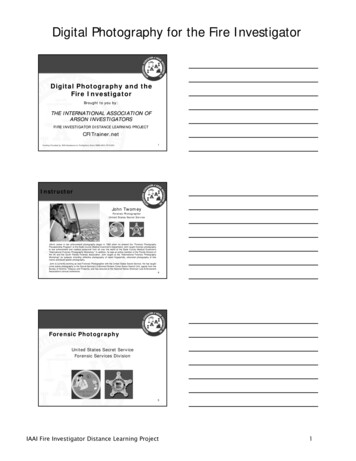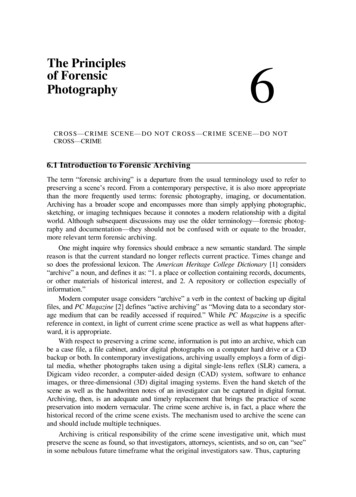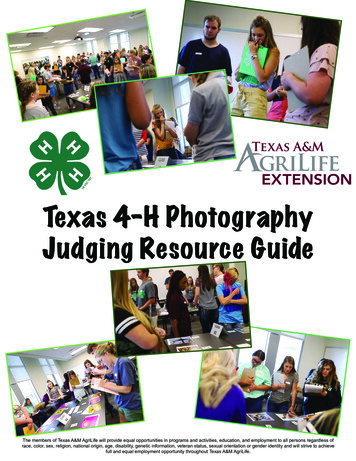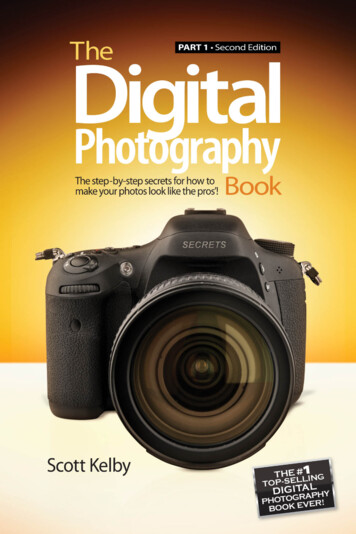
Transcription
Digital Photography for the Fire InvestigatorDigital Photography and theFire InvestigatorBrought to you by:THE INTERNATIONAL ASSOCIATION OFARSON INVESTIGATORSFIRE INVESTIGATOR DISTANCE LEARNING PROJECTCFITrainer.netFunding Provided by DHS Assistance to Firefighters Grant EMW-2003-FP-018311InstructorJohn TwomeyForensic PhotographerUnited States Secret ServiceJohn's career in law enforcement photography began in 1992 when he entered the "Forensic PhotographyPreceptorship Program" at the Dade County Medical Examiner's Department. John taught forensic photographyto law enforcement and medical personnel from all over the world at the Dade County Medical Examiner's"International Forensic Photography Workshop." In addition, he was an active member of the Florida Division ofthe IAI and the South Florida Forensic Association. John taught at the "International Forensic PhotographyWorkshop" on subjects including reflective photography of latent fingerprints, ultraviolet photography of bitemarks and blood spatter photography.John is currently working as lead Forensic Photographer with the United States Secret Service. He has taughtcrime scene photography to the Secret Service's Uniformed Division Crime Scene Search Unit, agents from theBureau of Alcohol, Tobacco and Firearms, and has lectured at the National Native American Law EnforcementAssociation's annual conference.4Forensic PhotographyUnited States Secret ServiceForensic Services Division5IAAI Fire Investigator Distance Learning Project1
Digital Photography for the Fire InvestigatorWhy take photos? Document evidenceDocument damage to propertyDocument injuries/death to victimsSupplement your notes and/or reportRefresh your memory for court6Why take photos? Used for further review later Can be important if someone was not there butneeds to understand what happened Presentation in court Good photographs make you look more professional Good photographs help the jury understand whathappened Administration of justice7Crime Scene Photography Identifiers An identifying photograph should be taken at thebeginning of a scene telling vital information such as: Date and timeCase NumberInvestigatorLocation8IAAI Fire Investigator Distance Learning Project2
Digital Photography for the Fire InvestigatorCrime Scene Photography Identifiers Photograph some point of reference in the scene that willassist later in identifying where the scene was located Street signs Addresses on houses Any other permanent point of reference910Crime Scene Photography Overall photographs Overall photographs should be taken depicting an entire areaof the scene as it was when you arrived. If the scene is toobig take a series of overlapping photographs Photographs should be taken from four sides of the scene ifpossible Try to exclude other officers/persons from photos Use numbered or lettered markers to show where importantareas are in the scene11IAAI Fire Investigator Distance Learning Project3
Digital Photography for the Fire Investigator121314IAAI Fire Investigator Distance Learning Project4
Digital Photography for the Fire Investigator15Crime Scene Photography Medium shot Shot of a particular area of interest taken with a normallens(50mm if possible) that shows all items of interest. These shots will be used to help show where close-upitems of evidence are located relative to the rest of thescene1617IAAI Fire Investigator Distance Learning Project5
Digital Photography for the Fire InvestigatorCrime Scene Photography Close Up After taking your medium shot move in close with amacro lens and photograph small items of detail.Include a scale whenever possible. When using a scale be sure to photograph perpendicularto the scale so it can be reproduced accurately if needed1819Crime Scene Photography Always photograph all areas of the scene, regardless ofwhether they may not seem to be important to the scene Details may emerge later which make these photographsimportant Film and/or hard drive space is cheap so take as many asyou need20IAAI Fire Investigator Distance Learning Project6
Digital Photography for the Fire InvestigatorCrime Scene Photography Work methodically so that photos are shot in a logicalsequence Make sure all necessary photographs are taken beforedoing destructive photographs Moving objects to get better shots Specialized techniques that may destroy evidence21Crime Scene Photography Using Flash When to use an electronic on-camera flash Indoor and/or backlit photographs Outdoor fill flash for shadowed areas Night photography22Crime Scene Photography Using flash Indoor Always use a flash indoors for proper lighting if not using atripod Backlighting The camera reads background light and will not fire theflash Many automatic cameras will not fire the flash in thissituation so you should have a camera that allows you totell it when to fire the flash23IAAI Fire Investigator Distance Learning Project7
Digital Photography for the Fire Investigator2425Crime Scene Photography Using flash In most cases automatic or TTL flash will work Some cases will require you to compensate by adding orsubtracting power from the flash Areas of heavy burn may require compensation on theflash in order to get more power– Black absorbs a lot of light26IAAI Fire Investigator Distance Learning Project8
Digital Photography for the Fire InvestigatorCrime Scene Photography Fill Flash Filling in shadowed areas of a photograph using flash Can make lighting more even when you have brightsunlight or other light sources272829IAAI Fire Investigator Distance Learning Project9
Digital Photography for the Fire InvestigatorCrime Scene Photography Night photography With Flash Flash falloff– The flash only goes a short distance so a large scene will beunder lit303132IAAI Fire Investigator Distance Learning Project10
Digital Photography for the Fire InvestigatorCrime Scene Photography Night photography With Flash Multiple flashes or “painting with light”– Adds more light if the scene is too large to be lit by a singleflash– Works well in areas where there are no streetlights or otherlight sources3334Crime Scene Photography Night photography Without Flash Time exposure– Opening the shutter for a long period of time and allowingother light sources such as street lights to illuminate yourscene– Requires a sturdy tripod– Allows jury to see the scene with natural lighting35IAAI Fire Investigator Distance Learning Project11
Digital Photography for the Fire Investigator36Equipment Considerations What do you need in a camera kit?Powerful external flash that’s made to work with your camera Flash sync cordMultiple lenses Good zoom lens and macro lens at least Tripod Cable release for shooting on tripod Accessories Batteries, rulers, film/digital media Oh yeah, a good camera37Equipment Considerations Lenses High quality optics are important Zoom lens that covers a wide range Wide angle Normal view Telephoto Macro lens capable of 1:1 focusing Wide aperture for lowlight shooting F 2.8 lens if possible38IAAI Fire Investigator Distance Learning Project12
Digital Photography for the Fire InvestigatorEquipment Considerations Flashes Powerful electronic flash Sync Cord for off-camera operation Infrared sensor for lowlight focusing Swivel head for bounce or close-up work TTL capability with camera Through-the-lens metering– The camera and flash communicate to give proper exposure39Equipment Considerations Camera A rugged professional camera, whether film or digital Strong durable bodyInterchangeable lensesAbility to set camera automatically and manuallyHot shoe and flash sync– Allows external flash and off-camera operation Various focus options Lowlight focusing40Equipment Considerations Practice shooting with your equipment prior to shooting acrime scene Check all camera settings prior to shooting a crime scene Ensure that equipment is working properly Select proper film/digital ISO for the situation you arephotographing Low light - Higher ISO Bright Sunlight - Lower ISO41IAAI Fire Investigator Distance Learning Project13
Digital Photography for the Fire InvestigatorIn the Courtroom Photographs must accurately depict the scene tobe admissible in court Good Composition and lighting Accurate color Distances cannot be distorted Accurate focus42In the Courtroom Photographs cannot be prejudicial No unnecessary blood or gore Must be relevant to the case being presented43In the Courtroom When presenting photographs in court the crimescene photographer must be able to tell the courtthe following items: When were the photographs taken The sequence in which they were taken The orientation and/or location of the items in thephotographs44IAAI Fire Investigator Distance Learning Project14
Digital Photography for the Fire InvestigatorIn the Courtroom Are digital photographs admissible in court? It differs by jurisdiction Many courts now accept digital images There are no known instances of photographs beinginadmissible solely due to the fact that they were takenwith a digital camera Check with your state/district attorney45In the Courtroom Important Cases Involving Digital Photography Almond v. The State– “We are aware of no authority, and appellant cites none, forthe proposition that the procedure for admitting picturesshould be any different when they were taken by a digitalcamera.”46In the Courtroom Important Cases Involving Digital Photography State of Washington vs. Eric Hayden State of Florida vs. Victor Reyes– In both cases digitally enhanced fingerprints were subjected to a Fryehearing and in both cases the fingerprints were admitted at trial– Reyes case ended up in acquittal however not due to the enhancementof the fingerprint evidence47IAAI Fire Investigator Distance Learning Project15
Digital Photography for the Fire InvestigatorIn the Courtroom Image Authentication Proposed law in Wisconsin noted that there is no case lawexcluding photographs solely on the basis that they were takenwith a digital camera, however it was suggested that some typeof image authentication be implemented Image Authentication can simply be a procedure in place toensure that the original photograph is that which is presented incourt48In the Courtroom Image Authentication Software is available that claims it can ensure that one image isidentical to another Most look at the file structure and use algorithms to verify that nochanges have been made Like any software, if someone wants to defeat it they probably can Is it necessary or will other procedures suffice?49In the Courtroom Image Authentication Original image should be preserved for the court and steps betaken to ensure that the practitioner can show that the presentedimage is the original SOP’s, Chain of Custody procedures, and Witness testimony History or written notes to document advanced enhancementtechniques SWGIT is currently discussing the issue of Image Authenticationin order to better understand what software is available and howit works50IAAI Fire Investigator Distance Learning Project16
Digital Photography for the Fire InvestigatorDigital Photography What captures the light? CCD or CMOS Sensor Captures light and turns it into and electronic signalSensor is made up of thousands of pixels(picture elements)Generally, the more pixels the better the imageHow many pixels do you need?– 6, 10, 12, 14, 22 megapixels– Depends on what you are photographing and what yourexpected output is– Does a first responder need the same camera that aninvestigator needs?51Digital Photography What captures the light? The image sensor can only capture grayscale image Most sensors are covered in a grid of colored filters inorder to make a color picture52Digital Photography Equipment Considerations Camera Why would you buy a low quality digital camera?– Cost– “Looks good on the monitor”– Ease of use Professionals should use professional equipment– Cost may be prohibitive but can be easily justified53IAAI Fire Investigator Distance Learning Project17
Digital Photography for the Fire InvestigatorDigital Photography Equipment Considerations Consumer Camera Small CCD sizePoor quality CCDPoor opticsSlow picture taking and writing to memoryFew FeaturesRelatively inexpensive54Digital Photography Equipment Considerations Pro-sumer Camera Larger CCD sizeGood opticsFaster picture taking and writing to memoryExtra featuresNot-so-rugged plastic bodyAbility to shoot uncompressed formatsMore expensive55Digital Photography Equipment Considerations Professional Camera Large CCD size, high pixel countHigh quality interchangeable lensesVery fast picture taking and writing to memoryExternal flashRugged durable bodyAbility to shoot uncompressed formatsExpensive56IAAI Fire Investigator Distance Learning Project18
Digital Photography for the Fire InvestigatorDigital Photography Equipment Considerations Lenses Typically the sensor size of a digital camera is smaller than35mm film, therefore the effective focal length of the lenschanges When using removable lens, the aspect ratio changes– Multiply lens focal length by approximately 1.5 to get effectivefocal length– 50mm lens becomes 75, 200mm becomes 300, etc.– Good for zoom lenses, bad for wide angle57Digital Photography Equipment Considerations Accessories for camera Batteries– The more you look at the monitor, the quicker you burn thebatteries Media– Higher mega-pixel cameras take up more drive space58Digital Photography Equipment Considerations Accessories for the laptop/desktop computer RAMDisk drivesUSB and/or fire wire portsCard readersLarge hard driveCD/DVD writerAdaptors for various media cards59IAAI Fire Investigator Distance Learning Project19
Digital Photography for the Fire InvestigatorDigital Photography Equipment Considerations Common types of printers InkjetDye sublimationLaserPhoto quality60Digital Photography Equipment Considerations Print resolution Inkjet printers can print at any resolution, though thehigher the better Other types of printers need a specific resolution, usuallyaround 300 pixels per inch61Digital Photography Equipment Considerations Print resolution Resolution needed to print at different sizes withoutresampling or interpolating the photo––––––4x6 @ 300 ppi Approximately 2 megapixels5x7 @ 300 ppi Approximately 4 megapixels8x10 @ 300 ppi Approximately 7 megapixels4x6 @ 150 ppi Approximately .5 megapixels5x7 @ 150 ppi Approximately .75 megapixels8x10 @ 150 ppi Approximately 2 megapixels62IAAI Fire Investigator Distance Learning Project20
Digital Photography for the Fire InvestigatorDigital Photography Digital Noise The collection of electrons at the pixel sites createscolored pixels in the dark areas of the photograph Noise is caused by: Low light or underexposed photographsLong exposure timesHeatHigh ISO settings63Digital Photography Digital Noise64Digital Photography Digital Noise65IAAI Fire Investigator Distance Learning Project21
Digital Photography for the Fire InvestigatorDigital Photography Digital Noise Shoot at the lowest possible ISO Daylight - 100 to 200 ISO Night - 400 - 800 If shooting timed exposures try to keep the exposuretime to a minimum Don’t expose camera to heat Noise reduction software is available as a last resort66Digital Photography The most common file formats are: JPEG(lossy compression) MPEG(video compression) TIFF(Uncompressed) TIFF LZW(Loss less compression) BMP(Bitmap) Raw Native to some professional digital cameras67Digital Photography Image Compression For forensic uses compression should not be used as itthrows away original information from the image Compression makes the image smaller by eliminatingsome of the original information in the photograph Saves hard drive space but image quality can suffer68IAAI Fire Investigator Distance Learning Project22
Digital Photography for the Fire InvestigatorDigital Photography69Digital Photography70Digital Photography71IAAI Fire Investigator Distance Learning Project23
Digital Photography for the Fire InvestigatorDigital Photography72Digital Photography File formats JPEG Use lowest compression and highest resolution Allow you to shoot more photos on a card Slight loss of image quality, depending on amount ofcompression TIFF Uncompressed file takes up a lot of drive space– 6 megapixel camera will yield 18mb color image Highest quality, no image degradation Raw Takes up less space than TIFF, more than JPEGNeeds proprietary software from manufacturerHigh quality imageSoftware allows you to make basic changes to image aftercapture Must be converted to other formats for printing or distributing73Digital Photography Storage considerations Large hard drive in the computer Large memory cards for the cameras CD or DVD or other for backing up files Larger solutions such as RAID devices74IAAI Fire Investigator Distance Learning Project24
Digital Photography for the Fire InvestigatorDigital Photography Enhancement vs. Manipulation Are you improving image quality or altering the image? Care must be taken and operating procedures followedwhen making adjustments to an image Maintain original image If advanced techniques are used document procedures andresave enhanced image Software may save edit history for you either as anexternal file or as metadata in the image file Practitioners should be trained in proper techniques75Digital Photography Basic Image Enhancement Techniques used to improve image quality Brightness and Contrast Adjustments, including dodging andburning Resizing Cropping Positive to negative inversion Image Rotation/inversion Conversion to grayscale White Balance Color Balancing/Correction Sharpening and Blurring76Digital Photography Image Enhancement Contrast and Brightness adjustments Making an image lighter/darker or adjusting contrast toimprove the appearance of the image77IAAI Fire Investigator Distance Learning Project25
Digital Photography for the Fire InvestigatorDigital Photography Image Enhancement Dodging and burning of an image is used to selectivelybrighten or darken certain areas of the photograph78Digital Photography Image Enhancement Resizing Changing the actual pixel count of an image(Interpolation)– Upsampling is adding pixels where none previously existed– Downsampling is removing pixels to make image smaller Care must be taken when increasing the size as image willstart to look pixelized when too many pixels are added Is done automatically a lot of times when printing a digitalimage Cropping Removing parts of the photograph This should only be done when printing– The original image should not be cropped and resaved79Digital Photography Image Enhancement White Balance/Color Balancing Adjusting color in an image for accurate color Adjusting for different lighting conditions Sharpening Basic sharpening of an image to improve print quality Amount of sharpening should depend on the image resolutionand output Over-sharpening will result in halos around edges andpixelization View the image at 100% for accurate preview of sharpness80IAAI Fire Investigator Distance Learning Project26
Digital Photography for the Fire InvestigatorDigital Photography Image Enhancement Sharpening Image on right is over-sharpened81Digital Photography Image Enhancement Techniques that should be avoided for forensic imaging Selective adjustments to certain areas of a photo– May introduce artifacts Spotting, Erasing, Rubberstamping, Cloning, etc– Anything that deletes details in an image or cuts out parts of theimage82Digital Photography Image Enhancement Techniques that should be avoided for forensic imaging Selective adjustments to certain areas of a photo83IAAI Fire Investigator Distance Learning Project27
Digital Photography for the Fire InvestigatorDigital Photography Image Enhancement Techniques that should be avoided for forensic imaging Spotting, Erasing, Rubberstamping, Cloning, etc.84Digital Photography What software to use Image Editing/Printing– The most expensive solution is sometimes not necessary– Get one that does what you need, such as basic editing, layoutand printing CD/DVD writing Data Recovery– Retrieves deleted images from storage media Digital Asset Management– Archiving and Storing All applicable software that comes with the various cameras,printers, etc, Specialized software– Noise reduction, sharpening, etc.85Digital Photography Pros View images immediately on scene No processing or sending out to a lab Color balance to any type of lighting condition Send files quickly to anywhere by email Ability to make corrections and enhancements Money can be saved over time Digital image cannot be fogged or degrade over time like film Copies can be made without any degradation86IAAI Fire Investigator Distance Learning Project28
Digital Photography for the Fire InvestigatorDigital Photography Cons Expensive up-front cost Images can be deleted accidentally Lower image quality with less expensive cameras Printing can be slow Long term archiving solutions Unknown how long CD/DVD’s last Hardware and software changing so fast things become obsoletequickly87Digital Photography Standard Operating Procedures Set standards that all practitioners can follow Make procedures repeatable Protect, archive and handle images as you would film However be sure to back up whatever archival media youselect Also make sure to have plans for images from major crimesthat need to be stored long term Make sure practitioners are properly trained on equipmentand procedures All equipment should be properly maintained andcalibrated for consistency88Digital Photography Standard Operating Procedures Always work and save images in an uncompressed or leastcompressed format if possible and use highest cameraresolution Copy originals to a read-only media such as CD-R as soon aspossible Save images in their native file format If possible use a camera that records EXIF data Embedded data from camera such as date, time, etc Make sure you have the correct date and time in the camera89IAAI Fire Investigator Distance Learning Project29
Digital Photography for the Fire InvestigatorDigital Photography Standard Operating Procedures Working on images in the computer Be specific about what techniques are ok to use and whatare not Be specific about what should be documented using notesor software history90Digital Photography Standard Operating Procedures Working on images in the computer Copy original image and work on copy Save the changes made to copy as a new file Backup images to another storage media– Duplicate CD or to hard drive/tape backup91Digital Photography How can digital photographs benefit you at acrime scene? Make sure you have the shot Change color balance and ISO without changing film Shoot without changing film repeatedly Download and print or transmit if necessary Shoot many more photographs without incurring addedprocessing and printing costs92IAAI Fire Investigator Distance Learning Project30
Digital Photography for the Fire InvestigatorDigital Photography Considerations Digital chip has sensitivity similar to slide film Less latitude means its easier to be over orunderexposed– Shoot another shot if you are not sure about exposure– Its better to be slightly underexposed than overexposed» Once there is white in the image you cannot get any moredetail– However if you are too underexposed you will lose detail andintroduce noise93Digital Photography Considerations The digital chip is exposed on many professional digitalcameras Dust can get into the camera when changing lenses and get onthe chip– This causes black spots on your images There are ways to clean chip but it is risky because you candamage or scratch the chip Be careful when changing lenses at scenes Use a blower brush if necessary to blow dust out of the inside Use a specially designed swab or other device to clean chip,however be extremely careful94QUESTIONS FOR THE INSTRUCTOR95IAAI Fire Investigator Distance Learning Project31
Digital Photography for the Fire InvestigatorCertificate of Completion andTestingTo take the test for this program andreceive a certificate of completion, select theTEST button on your screenWhen you finish the test you will beinstructed on how to print your certificate ofcompletion for this program96CFITrainer.netTHANK YOUWatch for new programs onCFITrainer.net97IAAI Fire Investigator Distance Learning Project32
Digital Photography for the Fire Investigator IAAI Fire Investigator Distance Learning Project 6 18 Crime Scene Photography Ceo Uslp After taking your medium shot move in clos










